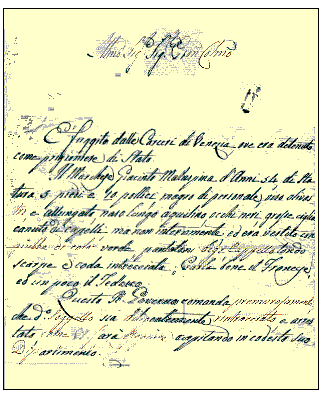Azzo Giacinto Malaspina (1746-ca.1800)

Not knowing of any portrait of him, we reproduce and transcribe here the description of his appearance issued by the Austrian police during his disappearance. This document is preserved in the Archivio Domestico dei Malaspina di Mulazzo (Mulazzo, at the Centro di Studi Malaspiniani, Mulazzo, Italy):
The Marquis Giacinto Malaspina has escaped from gaol in Venice, where he was held as a prisoner of state. He is 54 years old, 5 feet 10 inches in height, of slim build, with a long face and olive complexion, a long aquiline nose, dark eyes, long eyelashes and greying hair (though not entirely grey), and was dressed in a green coat, grey trousers, a round hat and shoes, with braided hair: he speaks French well and German a little.For more information, see:The Royal Government urgently requests that the said subject be diligently tracked down and arrested, which order Your Lordship will put into effect in this, his department. (Initials)
P. LITTA, Famiglie celebri italiane. Malaspina, Tav. VIII, Milano, Giusti, 1852.
E. BRANCHI, Storia della Lunigiana feudale, Pìstoia, Beggi, 1897-98, (also reprinted in facsimile form: Bologna, Forni, 1972), vol. I, pp. 452-471.
G. SFORZA, "Contributo alla biografia di Azzo Giacinto Malaspina ultimo Marchese di Mulazzo," Giornale Ligustico, XXII (1897), pp. 171-191.
G. SFORZA, "Un feudatario giacobino," Giornale Storico e Letterario della Liguria, IV (1903), Parts 1-3, pp. 5-46. [Includes the correspondence between Azzo Giacinto and Paolo Greppi.]
P. FERRARI, Un lunigianese fra i primi martiri della libertà italiana: Azzo Giacinto Malaspina, Pontremoli, Artigianelli, [1945], 14 pp.
D. MANFREDI, "Sulla sorte di Azzo Giacinto Malaspina ultimo feudatario di Mulazzo," Cronaca e Storia di Val di Magra, XVIII-XX /1989-1991, Aulla, 1992, pp. 119-135.
D. MANFREDI, "Apporti alla biografia di Azzo Giacinto III Malaspina di Mulazzo," Cronaca e Storia di Val di Magra, XXVI-XXVII / 1997-98, Aulla, 1998, pp. 151-179.
N. MICHELOTTI, "Gli anni bui di Azzo Giacinto, Luigi ed Alessandro Marchesi di Mulazzo," Archivio Storico per le Province Parmensi, Series IV, XLIX-1997, Parma, 1998, pp. 147-167.
Image courtesy of the Centro di Studi Malaspiniani, Mulazzo, Italy. Biographical and bibliographical notes by Dario Manfredi (Italian version), translated by John Black.